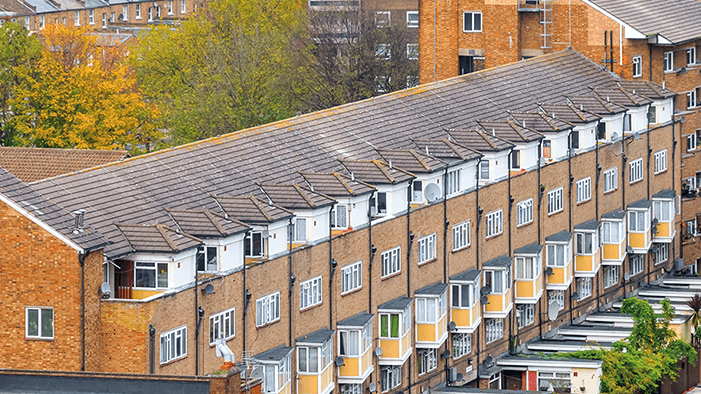Poor housing will cost over £135.5bn over the next 30 years without urgent action - BRE Group
Poor housing will cost over £135.5bn over the next 30 years without urgent action
- BRE’s latest analysis quantifies the vast cost of England’s poor quality homes.
- £9bn to improve 2.4mn poor homes in England would pay for itself within 9 years based only on NHS savings
- Wider social pay back of £135.5bn over the next 30 years
A new cost-benefit analysis published today by the Building Research Establishment (BRE) has revealed that remedial work to England’s poorest housing (1) could provide £135.5 billion (bn) in societal benefits over the next 30 years. These benefits include savings to the NHS, lower energy bills and carbon emissions, higher asset values and improved economic opportunities as a result of better health.
BRE’s latest report updates its 2021 research (2) and outlines a 30-year cost-benefit analysis of the impact of improving poor housing in England’. The Cost of Ignoring Poor Housing quantifies the enormous cost burden of England’s poor housing to wider society.

For the 2.4 million (mn) homes in England identified as having one of the most serious health and safety hazards (3), remedial works would cost £9bn. If all this work could be undertaken immediately, there would be accrued benefits of £135.5bn over the next 30 years. This includes £13bn of savings to the NHS. Currently, the NHS is estimated to be spending over £1bn a year on treating people affected by poor quality housing. Based only on the NHS savings, let alone the wider benefits, the £9bn investment would pay for itself within 9 years.
It is unlikely to be practically possible to identify and undertake all the work required to make England’s housing stock healthy and safe immediately. To help target action, and as part of its latest report, BRE has designed a cost-benefit model that can be used to assess the costs and benefits of taking action on different hazards under different scenarios.
According to BRE’s research, improving the 65,000 homes with a Category 1 damp and mould hazard would only cost £250mn, unlocking £4.8bn in societal benefit over the next 30 years if this work was to be undertaken immediately.
Gillian Charlesworth, CEO, BRE, commented: “Our analysis is a clear signal to policymakers that investing in the health and safety of England’s poor housing will deliver significant, long-term economic and societal benefits. Up until now, no serious attempt has been made to examine and quantify the longer-term costs and benefits if the worst health and safety hazards were removed from England’s substandard housing.
“Improving poor housing has huge implications for the life chances of the families who live in those homes, and benefits to society as a whole. Whether it’s a young family living with cold, damp and mould, or an older person at risk from falls, nobody should live in a home that’s unsafe. But our research shows there is much more than a moral case for tackling unsafe homes. There is also a powerful economic argument for England and the UK to deliver the improvements needed, through targeted and timely programmes of work to reap the financial payback.
“By building on our previous research, we hope to further inform local and national government where the most problematic homes are and provide a foundation for dedicating strategic resources to remediate poor housing for the benefit of individuals, the national economy, and wider society.”
Notes to Editors
For all press enquiries, please contact brepress@pagefield.co.uk
(1) For the purposes of BRE’s report, ‘poor housing’ is defined as ‘a dwelling that fails to meet the statutory minimum standard of housing in England’, i.e., a dwelling that contains one or more Category 1 Housing Health and Safety Rating System (HHSRS) hazards.
(2) https://bregroup.com/press-releases/bre-report-finds-poor-housing-is-costing-nhs-1-4bn-a-year/
(3) The Housing Health and Safety Rating System (HHSRS) assesses 29 housing hazards and the effect that each may have on the health and safety of current or future occupants of the property. The HHSRS provides a way that hazards can be assessed and the best way of dealing with them identified. If a hazard is a serious and immediate risk to a person’s health and safety, this is known as a Category 1 hazard. If a hazard is less serious or less urgent, this is known as a Category 2 hazard
Methodology
This new research uses the builds on the methodology originally developed for ‘The full cost of poor housing’ (2021 report) to calculate the initial cost burdens to the NHS for the first year of treatment and then the wider costs to society. It uses the 2019 English Housing Survey (EHS) data (and more recently published EHS HHSRS data where available) and NHS treatment costs as the underlying data for future projections and provides a further methodology on these projections. As with all our previous research a poor home is defined as ‘‘a dwelling that fails to meet the statutory minimum standard of housing in England’, i.e., a home that contains one or more Category 1 HHSRS hazards. There are 29 recognised HHSRS hazards 26 of which are collected for the EHS.
In summary, our approach was to:
1. Re-run the cost of poor housing modelled estimates on most up-to-date data sets.
2. Undertake a literature review to identify additional costs and benefits that can be quantified through these data sets.
3. Design a spreadsheet model to extrapolate these costs and benefits over 30 years, following Government ‘Green Book’ guidance.
4. Factor in changes to the profile of the housing stock (e.g. new builds and demolitions)
5. Run the spreadsheet under several intervention scenarios.
6. Make conclusions and recommendations.
